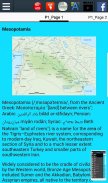








Ancient Mesopotamia History

Ancient Mesopotamia History介绍
Mesopotamia (/ˌmɛsəpəˈteɪmiə/, Ancient Greek: Μεσοποταμία "[land] between rivers"; from Ancient Armenian Միջագետք (Mijagetq); Arabic: بلاد الرافدين bilād ar-rāfidayn; Kurdish: میزۆپۆتامیا; Persian: میانرودان miyān rodān; Syriac: ܒܝܬ ܢܗܪܝܢ Beth Nahrain "land of rivers") is a name for the area of the Tigris–Euphrates river system, in modern days roughly corresponding to most of Iraq plus Kuwait, the eastern parts of Syria, Southeastern Turkey, and regions along the Turkish-Syrian and Iran–Iraq borders.
Widely considered to be one of the cradles of civilization by the Western world, Bronze Age, Mesopotamia included Sumer and the Akkadian, Babylonian, and Assyrian empires, all native to the territory of modern-day Iraq. In the Iron Age, it was controlled by the Neo-Assyrian and Neo-Babylonian Empires.
The Sumerians and Akkadians (including Assyrians and Babylonians) dominated Mesopotamia from the beginning of written history (c. 3100 BC) to the fall of Babylon in 539 BC, when it was conquered by the Achaemenid Empire. It fell to Alexander the Great in 332 BC, and after his death, it became part of the Greek Seleucid Empire.
Around 150 BC, Mesopotamia was under the control of the Parthian Empire. Mesopotamia became a battleground between the Romans and Parthians, with western parts of Mesopotamia coming under ephemeral Roman control. In AD 226, eastern part of it fell to the Sassanid Persians. Division of Mesopotamia between Roman (Byzantine from AD 395) and Sassanid Empires lasted until the 7th century Muslim conquest of Persia of the Sasanian Empire and Muslim conquest of the Levant from Byzantines. A number of primarily neo-Assyrian and Christian native Mesopotamian states existed between the 1st century BC and 3rd century AD, including Adiabene, Osroene, and Hatra.
Mesopotamia is the site of the earliest developments of the Neolithic Revolution from around 10,000 BC.[citation needed] It has been identified as having "inspired some of the most important developments in human history including the invention of the wheel, the planting of the first cereal crops and the development of cursive script, mathematics, astronomy and agriculture."
美索不达米亚(/ˌmɛsəpəteɪmiə/,古希腊:Μεσοποταμία“[土地]河之间”;从亚美尼亚古代Միջագետք(Mijagetq);阿拉伯语:بلادالرافدين比拉德AR-rāfidayn;库尔德:میزۆپۆتامیا;波斯语:میانرودان密檐罗丹;叙利亚:ܒܝܬܢܗܪܝܢ贝丝Nahrain“大河之地”)是底格里斯河,幼发拉底河系统的区域的名称,在现代天大致对应于大多数伊拉克科威特加,叙利亚,土耳其东南部的东部地区,与地区沿土耳其 - 叙利亚和伊朗 - 伊拉克边境。
被广泛认为是文明的发祥地之一的西方世界,青铜时代,美索不达米亚包括苏美尔和阿卡德,巴比伦,亚述和帝国,所有原产于现代伊拉克领土。在铁器时代,它是由新亚述和新巴比伦帝国控制。
苏美尔和阿卡德人(包括亚述人和巴比伦人)为主,从美索不达米亚文字记载的历史(约公元前3100年)开始到巴比伦的秋天在公元前539年,当它被阿契美尼德帝国征服。它落到亚历山大大帝在公元前332年,他去世后,它成为希腊塞琉古帝国的一部分。
大约公元前150年,美索不达米亚是安息帝国的控制之下。美索不达米亚成为罗马和帕提亚人的战场,美索不达米亚与西部地区短暂罗马控制下的到来。在公元226年,它的东部落到了萨珊波斯。罗马之间的美索不达米亚和萨珊帝国(公元395拜占庭)司一直持续到萨珊王朝的波斯和拜占庭从地中海东部的穆斯林征服公元7世纪穆斯林征服。许多主要的新亚述和基督教本土美索不达米亚国家的公元前1世纪和公元3世纪,包括阿迪亚波纳,奥斯若恩和哈特拉之间存在着。
美索不达米亚的新石器革命最早发展的网站从公元前约10,000。[来源请求]它已被确定为人类历史上,包括车轮的发明,第一种植具有“启发了一些最重要的发展谷类作物和草书,数学,天文学和农业的发展。“
























